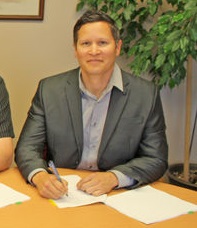Chief Troy Thompson of Kaweno:ke District, Mohawk Council of Akwesasne presents tribal border challenges for the Cornwall Island and St. Regis Indian Reservation located in Akwesasne Territory, which divides New York State from Quebec and Ontario. Chief Thompson spoke of the ongoing challenges for residents of Akwesasne that have to cross the international boundary daily to simply drop of their kids and go to work. The hassle and need for a renewed relationship is something that needs to be developed with Canada Border Services and other federal, provincial and state agencies for a better living and working relationship.
Attached in Chief Thompson’s Power Point presentation:
10-15-am-troy-thompson_obstacles-to-trade-presentation-of-november-12
The Mohawk Nation at Akwesasne (alternate spelling Ahkwesáhsne) is a Mohawk Nation (Kanien’kehá:ka) territory that straddles the intersection of international (United States and Canada) borders and provincial (Ontario and Quebec) boundaries on both banks of the St. Lawrence River. Most of the land is in what is otherwise the present-day United States. Although divided by an international border, the residents consider themselves to be one community.
It was founded in the mid-18th century by people from Kahnawake, a Catholic Mohawk village south of Montreal. Today Akwesasne has 12,000 residents, with the largest population and land area of any Kanien’kehá:ka community.[4] Beginning in the eighteenth century, Akwesasne was considered one of the Seven Nations of Canada. It is one of several Kanien’kehá:ka (Mohawk) territories within present-day Canada; others are Kahnawake, Wahta, Kanesatake, and the Six Nations of the Grand River First Nation, founded after the American Revolutionary War.
With settlement of the border between Canada and the United States, a larger portion of the territory was defined as being within the United States. The portion in New York state is known as the federally recognized St. Regis Mohawk Reservation.
The name Akwesasne in Kanien’kéha (Mohawk language) means “Land Where the Partridge Drums”, referring to the rich wildlife in the area.
Akwesasne territory incorporates part of the St. Lawrence River, the mouths of the Raquette and St. Regis rivers, and a number of islands in these three rivers. The territory is divided north/south by an international boundary. The northern portion is further divided by the Canadian provincial boundary between Ontario and Quebec.
The Three Nations Crossing connects Kawehno:ke (Cornwall Island, Ontario) to the City of Cornwall in the north and Rooseveltown, New York in the south.
Because of the St. Lawrence River to the north and New York State, USA to the south, the Quebec portion of the Akwesasne reserve is an exclave claimed by Canada. To travel by land from Tsi:Snaine (Snye or Chenail, Quebec) or Kana:takon (Saint Regis, Quebec) to elsewhere in Canada, one must drive through New York State.
In the U.S. state of New York, the territory of Akwesasne coincides with what is called the federally recognized St. Regis Mohawk Reservation. This portion of Akwesasne is bisected by New York State Route 37. This major state highway in the North Country of New York, extends for 127.40 miles (205.03 km) on an east-west axis.
In Canada, the territory within Ontario is called the Akwesasne 59 Indian Reserve, and the territory within Quebec is called the Akwesasne Indian Reserve.
(Source: Wikipedia)







